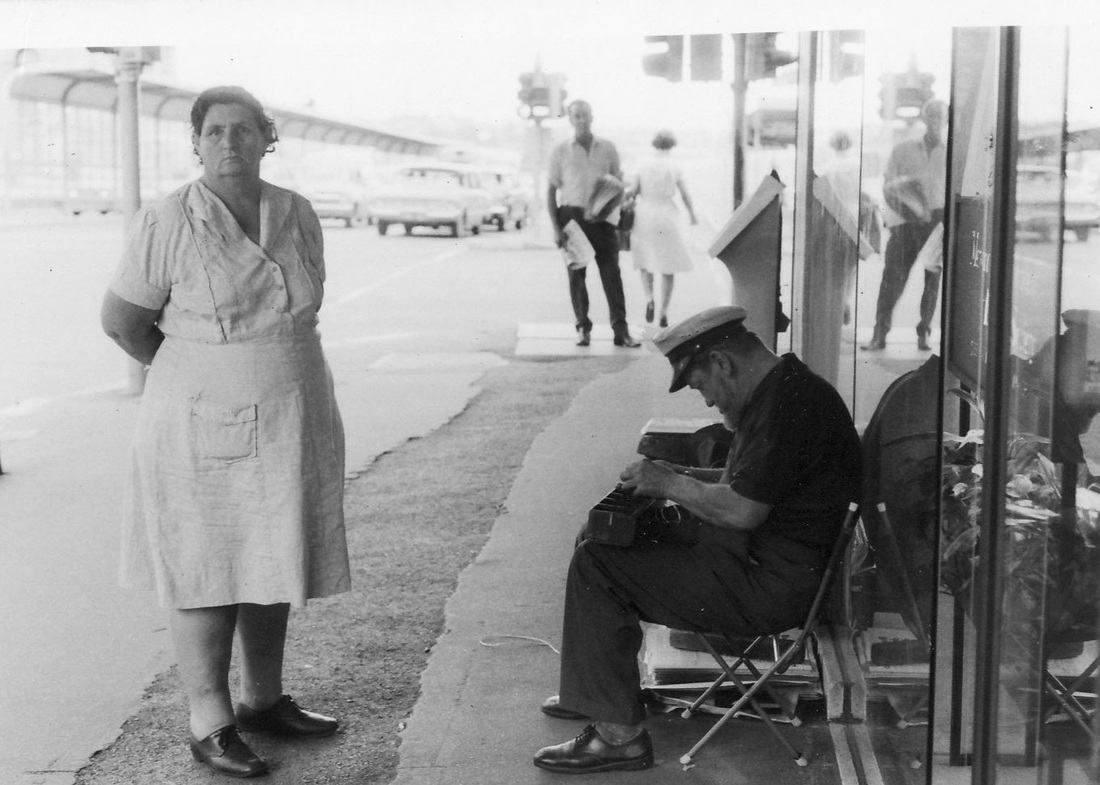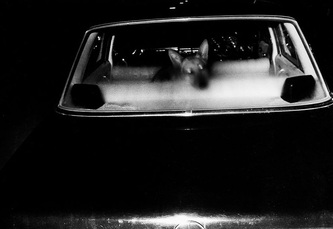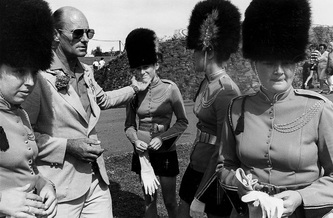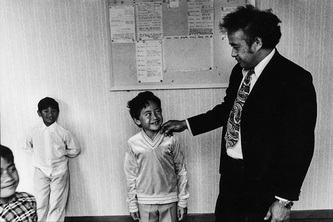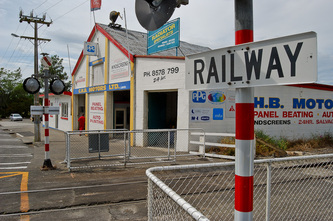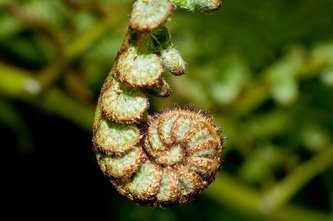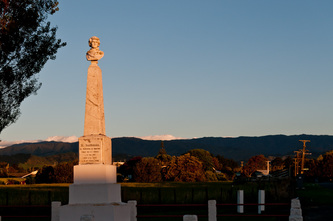About
" I think you should all have the courage to go on and to go further. To go further." Robert Frank
I was born in 1948 in Christchurch New Zealand. In 1973, wanting to make sure I could work my newly purchased duty free Pentax spotmatic, I took my very first photograph. Stepping out of the shop in Brisbane with a roll of black and white film in the camera I photographed a family of three newspaper sellers. It looks uncannily like my work many years later.
The film was developed by the local chemist, checked and forgotten about as I travelled on a two year backpacking odyssey through Asia, taking tourist snaps.
On my return to New Zealand I applied and was accepted (using that first b/w film as proof of ability) into the first course on photography offered by the then Wellington Polytechnic.
The course was geared at getting jobs in all facets of the medium. During a break from learning about commercial portraits I picked up a book left lying around by one of the tutors. It was a book of black and white photographs by Tony Ray-Jones and it was like a bomb going off in my brain. I saw that photography could be a personal art, with wit and intelligence. It could describe a new world, a photographic world.
After the course I free lanced for publications such as the NZ Listener, all the while taking personal photographs.
In 1978 I sold my first photographs to the then National Art Gallery. They were a series of six photographs of my parents-in-law called Ted and Ivy.
At this time photography was struggling to be accepted as an artform in New Zealand.My education about photography was obtained through magazines such as Creative Camera and monographs of overseas photographers. I still think publications are the best way to view work.
My Fifty Photographs show was the first one person show of photography at the National Art Gallery. The show was accompanied by a catalogue co-published with Photoforum. I helped establish the Wellington branch of Photoforum, as a sub set of the larger organisation in Auckland. It catered for photographers who wanted to use the exhibition space or book to reach an audience.
Photographs of this time such as Dog and Mercedes Benz, Samoan Twins and Selwyn Toogood have become favourite photos from this body of work for many.
At this time I was looking for perfect moments that had precise timing and composition that could stand alone.
Lara Strongman writing in my book Real Fiction said "his real achievement is to show not only the real life of the world, but its secret life as an image."
In 1984, because of the breakthrough process called Cibachrome that made saturated archival images from transparency film, I tried colour photography. This became a show called Made in NZ.
But tiring of the contrasty results and the expense, I returned to my own darkroom and black and white work.
Moving away from the heroic
In 1985 I completed the Foliage series of photographs showing the use of trees by man in the urban environment. They were my first box set of carefully sequenced images that connected one to another. Since that time I've continued to make limited edition sets and the Foliage work can be seen as my first attempt to move away from the single heroic image.
In 1986, becoming restless with the formal style I began taking random photographs without looking in the viewfinder. The resulting body of work was called Autoportraits. However, it was not exhibited and remained almost invisible until curator Greg O'Brien discovered it and exhibited it at the City Gallery as part of my survey show Real Fiction. Autoportraits was shown as a slide show accompanied by street sounds that I recorded.
This series of street photographs now seems part of exploring the limits of photographic form and content and giving an off balance experience of reality. I was excited by this method which seemed to break all the so called rules and challenged the photographic good taste of that time.
" Peter Black's photos would have stood out like a drunk who had inadvertently gatecrashed a party - all ragged and random street poetry, while everyone else dressed up in elegant conversation and costume." (Mark Amery Snap Happy - Real Fiction).
Wanting to continue this rough, raw and spontaneous method, in 1995, I set about to photograph New Zealand from the road (with drivers such as Lucien Rizos and Bruce Connew). Moving Pictures turned out to be my most socially charged work to date and described, in a poetic way, the changes that the right wing economics of Rogernomics had brought upon the country. The emotional charge of the work stems as much from the country's condition as the way the photographs were taken - a quick reaction to events without concious thought, from the heart rather than the brain.
I sequenced Moving Pictures like a European art movie and it has become one of my most enduring series. It was printed in the literary journal Sport as White Horse Black Dog. In Real Fiction Greg O'Brien wrote, " Moving Pictures is infused with a sense of loss."
I was born in 1948 in Christchurch New Zealand. In 1973, wanting to make sure I could work my newly purchased duty free Pentax spotmatic, I took my very first photograph. Stepping out of the shop in Brisbane with a roll of black and white film in the camera I photographed a family of three newspaper sellers. It looks uncannily like my work many years later.
The film was developed by the local chemist, checked and forgotten about as I travelled on a two year backpacking odyssey through Asia, taking tourist snaps.
On my return to New Zealand I applied and was accepted (using that first b/w film as proof of ability) into the first course on photography offered by the then Wellington Polytechnic.
The course was geared at getting jobs in all facets of the medium. During a break from learning about commercial portraits I picked up a book left lying around by one of the tutors. It was a book of black and white photographs by Tony Ray-Jones and it was like a bomb going off in my brain. I saw that photography could be a personal art, with wit and intelligence. It could describe a new world, a photographic world.
After the course I free lanced for publications such as the NZ Listener, all the while taking personal photographs.
In 1978 I sold my first photographs to the then National Art Gallery. They were a series of six photographs of my parents-in-law called Ted and Ivy.
At this time photography was struggling to be accepted as an artform in New Zealand.My education about photography was obtained through magazines such as Creative Camera and monographs of overseas photographers. I still think publications are the best way to view work.
My Fifty Photographs show was the first one person show of photography at the National Art Gallery. The show was accompanied by a catalogue co-published with Photoforum. I helped establish the Wellington branch of Photoforum, as a sub set of the larger organisation in Auckland. It catered for photographers who wanted to use the exhibition space or book to reach an audience.
Photographs of this time such as Dog and Mercedes Benz, Samoan Twins and Selwyn Toogood have become favourite photos from this body of work for many.
At this time I was looking for perfect moments that had precise timing and composition that could stand alone.
Lara Strongman writing in my book Real Fiction said "his real achievement is to show not only the real life of the world, but its secret life as an image."
In 1984, because of the breakthrough process called Cibachrome that made saturated archival images from transparency film, I tried colour photography. This became a show called Made in NZ.
But tiring of the contrasty results and the expense, I returned to my own darkroom and black and white work.
Moving away from the heroic
In 1985 I completed the Foliage series of photographs showing the use of trees by man in the urban environment. They were my first box set of carefully sequenced images that connected one to another. Since that time I've continued to make limited edition sets and the Foliage work can be seen as my first attempt to move away from the single heroic image.
In 1986, becoming restless with the formal style I began taking random photographs without looking in the viewfinder. The resulting body of work was called Autoportraits. However, it was not exhibited and remained almost invisible until curator Greg O'Brien discovered it and exhibited it at the City Gallery as part of my survey show Real Fiction. Autoportraits was shown as a slide show accompanied by street sounds that I recorded.
This series of street photographs now seems part of exploring the limits of photographic form and content and giving an off balance experience of reality. I was excited by this method which seemed to break all the so called rules and challenged the photographic good taste of that time.
" Peter Black's photos would have stood out like a drunk who had inadvertently gatecrashed a party - all ragged and random street poetry, while everyone else dressed up in elegant conversation and costume." (Mark Amery Snap Happy - Real Fiction).
Wanting to continue this rough, raw and spontaneous method, in 1995, I set about to photograph New Zealand from the road (with drivers such as Lucien Rizos and Bruce Connew). Moving Pictures turned out to be my most socially charged work to date and described, in a poetic way, the changes that the right wing economics of Rogernomics had brought upon the country. The emotional charge of the work stems as much from the country's condition as the way the photographs were taken - a quick reaction to events without concious thought, from the heart rather than the brain.
I sequenced Moving Pictures like a European art movie and it has become one of my most enduring series. It was printed in the literary journal Sport as White Horse Black Dog. In Real Fiction Greg O'Brien wrote, " Moving Pictures is infused with a sense of loss."
From Fifty Photographs
Landscape
I thought if I repeated the Moving Pictures style, it could become mannered, so in 1998 I changed direction. Using a more restrained approach with a medium format camera on a tripod, I took on landscape photography. Noting the changes to the environment in a huge land development on the hills near my home I spent the next two years photographing the series Sites.
Sites differs from the topographical work done a little earlier by artists such as Lewis Baltz. While also not sentimentalising nature, the work is less deadpan. The concern of the work is the exploitation of natural resources, while acknowledging that people need new housing.
I thought if I repeated the Moving Pictures style, it could become mannered, so in 1998 I changed direction. Using a more restrained approach with a medium format camera on a tripod, I took on landscape photography. Noting the changes to the environment in a huge land development on the hills near my home I spent the next two years photographing the series Sites.
Sites differs from the topographical work done a little earlier by artists such as Lewis Baltz. While also not sentimentalising nature, the work is less deadpan. The concern of the work is the exploitation of natural resources, while acknowledging that people need new housing.
Vox Humana
Returning to a small hand held camera I completed a documentary work Vox Humana with composer Jack Body about forms of workship around Wellington. It was shown at the Goethe Institute in 1992 accompanied by Jack Body's recorded music.
Composite works
In 1995-1997 I completed three series of composite photographs under the titles of Getting Better, New Way and Retro.
Aware that the art world (where my practice was situated) had changed its views on expressive documentary, these series of mostly found photographs was at once an attempt to fit in and to criticise post modern trends. Careful sequencing and a social point of view were an important part of these rather distainful bodies of work.
Back to the streets
In 2003, learning that the Police were moving the homeless out of the central city, I returned to the streets. This body of work called Public is my last black and white work to date. It can be read as a decline and fall story, dark in content and mood. (Concurrently with Public, I completed a more light hearted surreal series called Memory).
Digital colour
In 2007 I returned to colour, excited by the quality and the control of the process with high end digital printers. With my partner Mary Macpherson, I set up an in-house digital lightroom .It is now possible to get better print quality using digital technology than in a pro lab, and I felt at this time I had said all I could say with monochrome.
Four bodies of work have been produced so far - Outskirts, New Colour, At Home and i loved you the moment i saw you.
Outskirts continued my quest to photograph the disregarded, this time rather than people, the storage and distribution warehouses and small businesses found on the margins of the city. Some of these buildings are highly coloured to attract the eye, while others are minimal and stark. I wanted to control the colour by, for example, picking out the purple of a van in front of a grey building. I wanted control of the form, space and colour as much as possible. My aim was to keep the form in harmony with the content.
New Colour (2009) photographs were taken all over the country in order to take the pulse of the nation at that particular time. In these photographs I was especially concerned to describe the quality, temperature and colour of the light, which is only hinted at in black and white photographs.
At Home (2010) may be seen as a Pakeha (European) search for identity in a land that was first settled by the Maori. As well as irony, I tried to find space for wit and beauty.There are also images of tourists on their own search of New Zealand.
I Loved You The Moment I Saw You marked a return to street photography in 2010. Similar in intent to Public, I wanted to see if colour could be as strong with this type of subject matter. Black and white has the advantage of an inbuilt romanticism but now lacks a contemporary feel and can look like an out-of-date language. Colour describes more.
Because the recession was biting hard I thought it was time to do a series about all people, the young, elderly, the well off and the poor. I hoped this would serve as a microcosm of all New Zealand. Finally the story is the journey we all make, from innocence to old age.
Because the recession was biting hard I thought it was time to do a series about all people, the young, elderly, the well off and the poor. I hoped this would serve as a microcosm of all New Zealand. Finally the story is the journey we all make, from innocence to old age.
The work continues on with the grass is awfully green series, and I will continue try to push the boundaries of style, form and content.
I simply fell in love with photography when I saw the Tony Ray-Jones book in 1975. I learnt that if a photographer had direct engagement with the world they could produce a genuine work of fine art.
Of course photos can have the magical ability to stop time and thus allow us to examine the world, but in the end the best of them become art - yet they remain as mysterious as a dream.
Peter Black
I simply fell in love with photography when I saw the Tony Ray-Jones book in 1975. I learnt that if a photographer had direct engagement with the world they could produce a genuine work of fine art.
Of course photos can have the magical ability to stop time and thus allow us to examine the world, but in the end the best of them become art - yet they remain as mysterious as a dream.
Peter Black
